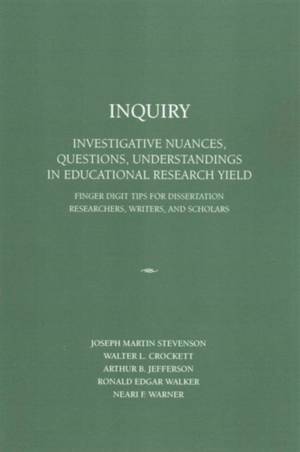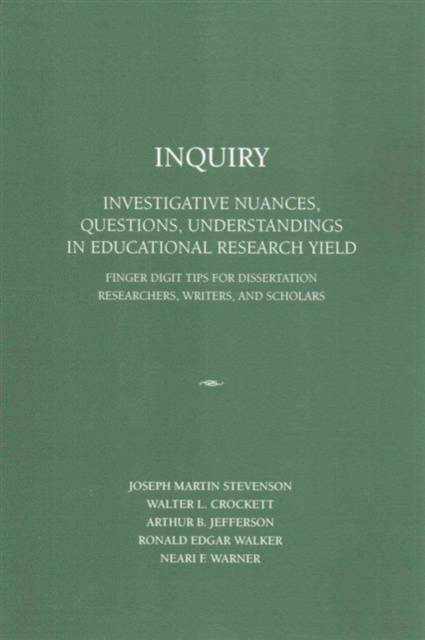
- Afhalen na 1 uur in een winkel met voorraad
- Gratis thuislevering in België vanaf € 30
- Ruim aanbod met 7 miljoen producten
- Afhalen na 1 uur in een winkel met voorraad
- Gratis thuislevering in België vanaf € 30
- Ruim aanbod met 7 miljoen producten
Zoeken
Inquiry
Investigative Nuances, Questions, and Understandings in Educational Research Yield
Joseph Martin Stevenson
Paperback | Engels
€ 68,45
+ 136 punten
Omschrijving
The authors of this book workbook précis or primer are senior professors, dissertation advisors, and seasoned administrators for a research university in the Deep South. Our title INQUIRY reflects the book s aim to help readers with the principles of research scope concerning investigative (examination); nuances (meaning); questions (evoke); in (throughout); research (scientific) yield (return). The book was generated from many discussions over the years about the quality of dissertations and the organizational challenges experienced by doctoral students before, during and after the dissertation prospectus or proposal stage. The content of this book was driven, motivated, and derived from formative feedback given by some of our doctoral students who completed a series of pre-dissertation proposal workshops. We have attempted to address all of their typical inquiries, concerns, challenges and issues in the pre and post dissertation proposal process. We have attempted in our short book to capture these challenges and address them in a very succinct précis by identifying ten basic digits for planning the dissertation proposal process and beyond for the lifelong researcher. However we also spend a great of time making suggestions in the preplanning process prior to the ten step process. We recommend that doctoral students seek out separate readings for some of the fundamental components of traditional qualitative research relative to areas such as varying research designs, biography, case study, ethnography, grounded theory, phenomenology, and other elements of conventional quantitative research like instrumentation, sampling, variables, testing, and other statistics. We call our digits finger tip because the writing and word processing of the dissertation are the manifestation of work from the finger tips of the human hand based on the thinking constructs generated from the mind. Therefore, research derived from the process of dissertation thinking, engaging and writing is the result of cognitive and relational symmetry between the human mind and the human hand. An exercise we have used with our students involves each student putting on latex gloves and writing the chapter initials and numbered digits at the bottom of each finger. This allows the student to look at all finger digits that represent the all sections of the dissertation proposal, while typing about the dissertation on a computer key board. Given this profound psychological, physiological and metaphorical synergy, mind-to-hand coordination, we have chosen each finger of the hand to symbolize each step in our précis. The left and right hands each have five digits, thumb, index, middle, ring, and little. The scientific designation for each, the thumb, index, middle, ring and little fingers are the 1st, 2nd, 3rd, 4th, and 5th. The final dissertation has five chapters and five finger digits from the hand can intersect the psychological, physiological and metaphorical dimensions. After a comprehensive introduction, our book chapters are organized in a way to engage students of the dissertation process from looking at their hands beginning with the left thumb as the first digit to symbolize the stage of thought or idea provocation; the second left index digit as the literature review; the third left middle digit as the theoretical framework; the fourth left ring digit as the research questions; and the fifth left little digit as the hypothesis stage (or step). The right hand fingers represent the remaining key five chapters. The right thumb symbolizing research design; the right index for instrumentation; the right middle for data collection/coding; the right middle for data analysis; and the right little for data findings.
Specificaties
Betrokkenen
- Auteur(s):
- Uitgeverij:
Inhoud
- Aantal bladzijden:
- 146
- Taal:
- Engels
Eigenschappen
- Productcode (EAN):
- 9781936320974
- Verschijningsdatum:
- 10/02/2015
- Uitvoering:
- Paperback
- Formaat:
- Trade paperback (VS)
- Afmetingen:
- 152 mm x 226 mm
- Gewicht:
- 226 g

Alleen bij Standaard Boekhandel
+ 136 punten op je klantenkaart van Standaard Boekhandel
Beoordelingen
We publiceren alleen reviews die voldoen aan de voorwaarden voor reviews. Bekijk onze voorwaarden voor reviews.







